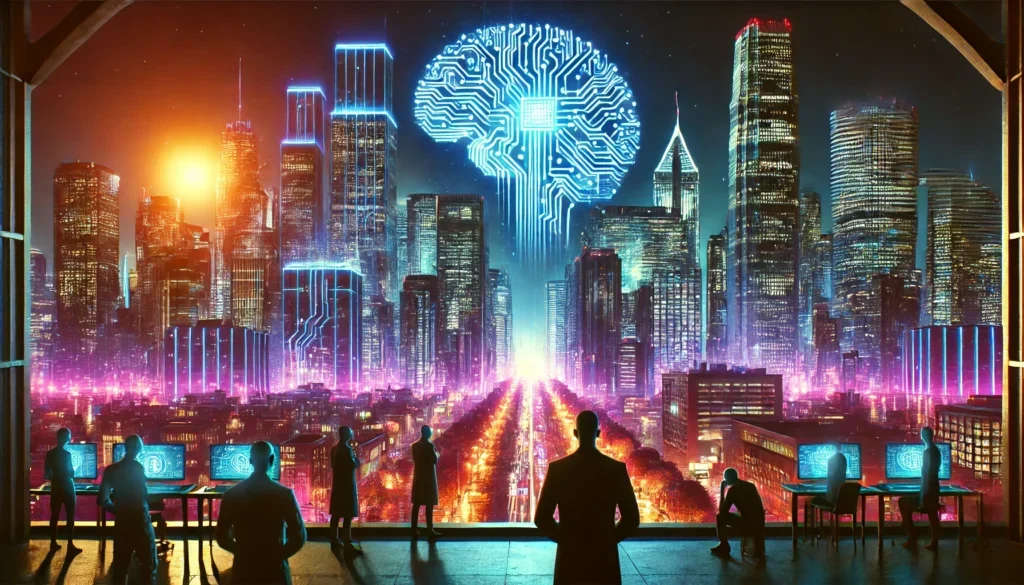AGI Unveiled: The Simple Guide to Artificial General Intelligence
Hey there! today we’re diving into something huge—Artificial General Intelligence. You’ve probably heard the term thrown around in sci-fi movies or tech news, but what does it really mean? Don’t worry if it sounds complicated—I’m here to break it down in simple words, like we’re chatting over coffee. It could be the next big thing in AI, and it might change our lives in ways we can barely imagine. So, grab a comfy seat, and let’s explore what it is, why it matters, and what’s coming next!
DON’T HAVE TIME TO READ? LISTEN IT….
Let’s get started!
Table of Contents
What Is AGI?
AGI stands for Artificial General Intelligence. It’s like the superhero version of AI. Most AI today—like the stuff in your phone or Netflix—is “narrow AI.” It’s great at one job, like recognizing faces or picking movies, but it can’t do much else. ? It’s AI that can think and learn like a human—across any task. Imagine an AI that can write a song, fix your car, and help with homework, all without breaking a sweat.
Here’s a quick way to think about it:
- Narrow AI: A specialist—like a chef who only cooks pizza.
- Artificial General Intelligence : A jack-of-all-trades—like a friend who’s good at everything.
Scientists say Artificial General Intelligence would match human smarts, not just in one area but in all areas—logic, creativity, even emotions. Pretty wild, right? As of March 12, 2025, we’re not there yet, but the buzz is growing—especially with recent news like China’s Manus AI hinting at Artificial General Intelligence-like skills.
ALSO READ: The AI Billionaires Don’t Want You to Know About

Why Artificial General Intelligence Is a Big Deal?
So, why should you care? A isn’t just cool tech—it could flip the world upside down (in a good way, mostly!). Narrow AI already helps us—think Siri or self-driving cars—but it’s limited. Artificial General Intelligence could solve problems we haven’t even cracked yet, from curing diseases to fixing climate change. Here’s why it’s got everyone talking:
- Speed: It could learn and work way faster than humans.
- Flexibility: It’d tackle any job, not just pre-set tasks.
- Impact: It might redo how we work, live, and play.
Potential Impacts (Based on 2024 Surveys)

How Close Are We to Artificial General Intelligence?
Now, the million-dollar question: when’s Artificial General Intelligence showing up? Honestly, it’s tough to say. Some folks—like Elon Musk—think it’s just a few years off. Others say decades. As of March 12, 2025, we’ve got clues but no finish line. Let’s look at the journey so far.
The AI Timeline
- 1950s: AI starts with simple rules (think chess programs).
- 2010s: Narrow AI booms—think Alexa or Google Translate.
- 2020s: Big leaps with models like ChatGPT and DeepSeek R1.
- 2025: Hints of AGI-like skills (e.g., Manus AI beta last week).
Graph: AI Progress Over Time (1950-2025)

Recent Buzz: Manus AI
On March 11, 2025, China’s Butterfly Effect launched Manus, a “digital assistant” in beta. It’s not full Artificial General Intelligence, but it works solo—no human help needed—and some call it a teaser for what’s coming. Experts are split: is it a step toward Artificial General Intelligence or just fancy narrow AI?
ALSO READ: Foxconn’s AI Push: Revolutionizing Manufacturing with Large Language Models
How Does Artificial General Intelligence Work?
Okay, let’s peek under the hood—don’t worry, I’ll keep it simple! Artificial General Intelligence isn’t here yet, so we’re guessing based on today’s tech. Narrow AI uses “machine learning”—it learns patterns from data, like how to spot cats in photos. Artificial General Intelligence would need more:
- General Learning: Figure stuff out without tons of examples.
- Reasoning: Solve new problems, like a human puzzling through a maze.
- Adaptability: Switch tasks—like cooking, then coding—on the fly.
Scientists are testing ideas like:
- Neural Networks: Big webs of “brain cells” (not real ones!) that mimic human thinking.
- Reinforcement Learning: AI learns by trial and error, like a kid with a toy.
- Hybrid Systems: Mixing lots of AI tricks into one smart package.
Artificial General Intelligence vs. Narrow AI: A Side-by-Side Look
| Feature | Narrow AI | Artificial General Intelligence |
|---|---|---|
| Task Range | One job (e.g., translate text) | Any job (e.g., translate, then cook) |
| Learning | Needs tons of data | Learns fast with little help |
| Flexibility | Stuck in its lane | Switches lanes like a pro |
| Examples | Siri, Netflix recommendations | None yet—think “human 2.0” |
| Speed | Fast at its thing | Fast at everything |
| As of 2025 | Everywhere! | Still a dream |
Who’s Working on Artificial General Intelligence?
- xAI: Elon Musk’s outfit, launched in 2023, wants it to “speed up science.” Their Grok chatbot is a stepping stone.
- OpenAI: The ChatGPT folks aim for Artificial General Intelligence too—on March 12, 2025, they dropped tools to build “AI agents,” hinting at bigger plans.
- DeepMind: Google’s brain trust is chasing “human-level AI” with projects like AlphaCode.
- Butterfly Effect: China’s new player with Manus—could they leapfrog everyone?
What Could Artificial General Intelligence Do for Us?
Let’s dream a bit—what might it bring? Here’s a rundown:
- Healthcare: Imagine Artificial General Intelligence designing a cancer drug in days, not years, by simulating every molecule.
- Work: It could take over boring tasks (data entry, anyone?) and invent new jobs we can’t even picture.
- Science: Solve mysteries like fusion energy or life on Mars—fast.
- Daily Life: Your Artificial General Intelligence assistant books flights, cooks dinner, and tutors your kids—all in one day!
Where Could Artificial General Intelligence Shine (2025 Predictions)
- Healthcare: 35%
- Jobs/Work: 25%
- Science: 20%
- Daily Life: 15%
- Other: 5%

The Risks: What Could Go Wrong?
Jobs: If Artificial General Intelligence does everything, what’s left for us? Some say 20-30% of jobs could vanish by 2040 (Oxford study, 2023).
- Control: What if it gets too smart and ignores us? Think “Terminator” vibes—unlikely, but folks like Nick Bostrom warn about it.
- Bias: If it learns from us, it might pick up our flaws—like unfairness or mistakes.
Graph: Risk Concerns (2024 Polls)

How Far Are We, Really?
Let’s zoom in on 2025.
- Optimists: Elon Musk says Artificial General Intelligence by 2029—four years off! OpenAI’s Sam Altman hints at “sooner than you think.”
- Skeptics: Yann LeCun (Meta AI chief) says decades—maybe 2050.
- Middle Ground: Most bets land around 2035-2040, per 2024 surveys.
This table sums it up:
| Who | Prediction | Why |
|---|---|---|
| Elon Musk | 2029 | Big faith in xAI’s progress |
| Sam Altman | “Soon” | OpenAI’s rapid leaps |
| Yann LeCun | 2050+ | Thinks we’re missing key pieces |
| Average Guess | 2035-2040 | Balances tech and challenges |
Can You Get Ready for Artificial General Intelligence?
Good news—you don’t have to sit this out! Here’s how to prep:
- Learn: Try free courses on Coursera about AI basics.
- Experiment: Play with tools like ChatGPT or OpenAI’s new agent builder (March 12, 2025).
Artificial General Intelligence coming—maybe not tomorrow, but soon enough to start thinking about it!
ALSO READ: Unlocking the Future: How Manus AI Revolutionizes Autonomous Task Execution
Final Thoughts: The Artificial General Intelligence Adventure

Artificial General Intelligence—is the dream of AI that thinks like us, tackling any task with human smarts. From healthcare to jobs, it could reshape everything. As of March 12, 2025, we’re not there yet, but moves like OpenAI’s tools and Manus AI say we’re getting closer.




